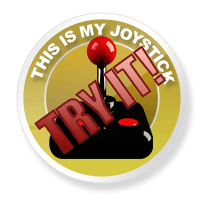Reviews
Review: Shinobi
December 2, 2011, Author: Andy Corrigan
Mention the name ‘Shinobi’ to any older gamers you know and they’ll probably get all misty-eyed and start looking upwards and slightly to the left, as they recount the fun times they had in the arcades or on their Mega Drives back in the good old days. Feel free to snap your fingers at this point to bring them back out of a warm, fuzzy cloud of nostalgia. The original game was undoubtedly a classic, but also a product of its time; a brutally challenging game that was designed to get those coins out of your pockets and into the arcade machines.
Since those 16-bit days, the franchise has seen moderate to limited success on more recent platforms, but it’s fair to say that the Shinobi name is no longer what it was. Still, such is its status as a classic franchise, we can expect to see it keep coming back again and again, and most recently SEGA tasked Griptonite Games with the task of recapturing the old school magic in an entirely new title for 3DS.
How did they do?
We’re into Ninjary time…
In this 3DS outing, you play as Jiro Musashi (apparently father of the Ninja from the original Shinobi), as the game starts in an ancient, quiet little Japanese village. Jiro and his master are busy meditating, while his mentor imparts important wisdom on the art of being a ninja, explaining how you need to be silent and should only need one strike to end a fight; basically all the things that Jiro will completely disregard throughout.
Suddenly, they are interrupted by hordes of attackers from a rival clan. After fighting his way out, Jiro ends up in the future, fighting gun-toting robots for reasons that are not entirely clear. Throughout he’ll encounter a female soldier called Sarah (whose name I only know from the title of the video file in the extras menu) who is not his friend, then suddenly is his friend, after they communicate with each other by only pointing, with all the mannerisms of lost children who were too scared to speak.
As you can tell, none of this is explained very well throughout, blurring together meaningless cut-scenes with style over substance. There’s no clear goal other than beating the game. In fact, I’ve watched all the cut-scenes four times apiece to attempt to get enough understanding to explain to you what the chuff was going on, and aside from defending his village, I’m not even sure what Jiro’s stake in the entire affair is.
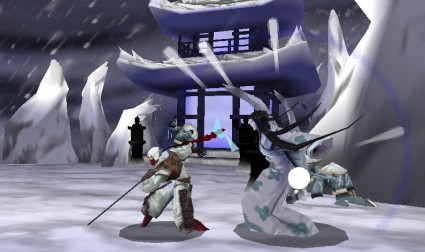
The boss fights are formulaic but a challenge...
Old schoolin’
Still, forgettable story aside, it’s a game that’s all about old-school challenge, and this is well highlighted by the fact that the content barely changes across its four difficulty levels; only the rules that you’re playing by do. Even the Normal difficulty is painfully trying within the boundaries set for you, and the game can be a huge test of one’s patience.
To explain, playing on Normal difficulty will see you with auto-saves enabled between levels, five lives, but infinite continues. Should you lose all those five lives during a level, you can continue as often as you like, but the caveat is that each time you perish you’ll be sent all the way right back to the beginning of the current level.
It sounds more than fair enough, but these levels are extraordinarily large, spanning several stages with no interim checkpoints, and no matter how long you were playing (30-40 minutes or more in some cases), misstep too many times and you’ll find yourself right back at the beginning. That, my friends, is truly a heart-breaking feeling.
If you step the difficulty up a notch it gets worse. You’ll looking at three lives and just three continues, no auto-saving. Lose all your lives and you’re back to the beginning of the entire game. The Very Hard difficulty even tells you upfront that “No one can beat this difficulty”, and after struggling a lot through the Normal difficulty, and dabbling in the harder levels for the sake of review, I fucking well believe them too.
For those who are faint of heart and just want to just fly through unimpeded, Easy is the choice for you, with infinite lives and the ability to save at the start of a new stage within a level (even then, the game does its best to slow you down). If you go this way, though, you’ll lose out on a lot of the satisfaction from learning what a given level has to throw at you and working your way towards beating it. If you can’t stand a game that will beat you down again and again until you find the resolve to overcome it, then you’re not going to have fun with this game in any capacity.
In no way does this make the game terrible; it is by design, in fact. It does, however, make it suited to a certain type of player, those who find getting over that frustration a far more rewarding experience. The fact that with this remit Griptonite have achieved their goal doesn’t stop it from being a tad too repetitive over the course of a playthrough, however.
The core gameplay comes in the mould of a 2.5D platformer, where you’ll be heading left to right for most part, dispatching enemies and trying to get through unharmed until you find the big, scary boss at the end of the level. It’s pretty linear, although there are some mild deviations from the beaten track if you’d like to find them, along with the odd secret to find along the way too.
Of course, stopping you from getting to the other side are an entire boatload of enemies, environmental hazards and mini-bosses. There are different types of enemies to face; mêlée specialists, various projectile launchers, armoured and high-powered soldiers, but dispatching of them doesn’t ever drastically change all that much between the classes. For the variation there is, once you’ve worked out the best way to take them down, the hardest part is avoiding their attacks (and admittedly, that at times can be pretty damn hard).
Fighting the hordes can become a very rigid experience, as your standard foes never vary in their attacks and are stuck with their basic, preset animations. The challenge comes in their numbers and the combinations that the game throws at you, and it can be hard to go forward two steps without being hit in the face.
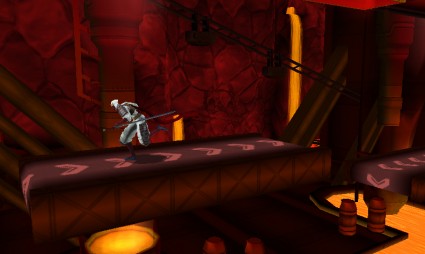
The visuals can be painfully drab...
The rigidity also comes into play when controlling your own character, controlling ever so slightly sluggishly; though, you do have a nice range of attacks to your arsenal aside from the usual throwing knives (Kunai, which regenerate after a cool-off period) and basic combos with your sword. Both types of attacks have simple air variations, but there are also some high-powered equivalents, such as a slam to the ground and a fan-shaped distribution of knives. You also can parry all enemy attacks with a well-pressed tap of the R shoulder button, but getting the timing to successfully do this can be a fine art.
You also have a few tricks to help you traverse the levels. If a ceiling is low enough, you can grab onto it and move across the top of the screen. On certain surfaces you can then shift up a level onto a platform, and if the roof is just out of reach, you can press the X button to utilise your character’s grapple-hook. The latter can be a huge lifesaver when you’ve mis-timed a jump.
Being a game that prides itself in its difficulty, health does not replenish; instead you’ll be looking to find pieces of chicken, because (as all gamers know), food fixes injuries! Of course, with all the game throws at you, you’re going to be overwhelmed until you learn what’s coming around the corner; so, to get you out of a jam you can activate Ninja Magic at a tap of the left bumper, after selecting it on the touchscreen.
There are four types available, and they’re a great fallback to help you out of a jam. The one I used the most was Fire Magic, which clears the screen of susceptible enemies, while also temporarily imbuing your weapons with fire effects. Earth Magic enables an auto-block for a short period, while Lightning prevents you from taking damage for three hits from both enemies and environmental hazards. Finally, Water Magic speeds you up and increases your jump range. The use of magic is not unlimited and usually you’ll only get to use one per level; however, if you can find an ancient scroll along the way, you’ll get another shot.
There are a couple of power-ups alongside the scrolls and chicken, and they too are usually found in the crates littered around the levels. You’ll find extra lives (essential if you’re to stand a chance on anything above Easy), temporary weapon boosts, and if you can find a Bonus Coin you’ll unlock Kunai Blitz Bonus Rounds. If you can find the two skull-branded coins in each level, you’ll also unlock new challenge maps to play.
The boss fights are cool in their own formulaic way, but they’re never quite the puzzle they seem to set out to be, and once you’ve worked out their attack pattern and movement, you’ll have them nailed without too many issues. They are however, larger-than-life and a challenge to beat the first time; you’ll find yourself battling tanks, wizards, mutated ninjas and even robots, all with their own devastating attacks.
The game tries to break things up by adding some horse and vehicle sections. In terms of vehicles, rather than driving, you’ll find yourself surfing on top of trucks and planes, jumping between them and fighting off enemies to stay alive, while the horse-riding moments amount to a game of ‘dodge the trees’. It’s refreshing when these stretches come along, but they tend to be fairly short and are never quite enough to rescue a largely repetitive game.
To be fair, though, there’s a lot of content packed in Shinobi to be unlocked (some through an inbuilt achievement system, some through progression), including artwork, video and music libraries, and there’s the history of the entire series to read up on too. There’s a dojo to prat about in, a Freeplay mode to unlock where you can enable cheats (such as using a certain Golden Axe instead of your sword), and something I only discovered late on in the review process; a recording feature, allowing you to save an entire playthrough of a level to watch again and again in the theatre. For people who dig what the core game is offering, you’ll find enough to keep you coming back for more.
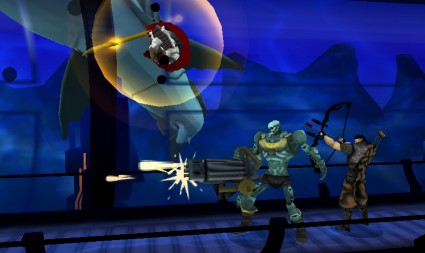
It's all ninjas, ninjas, ninjas... then suddenly, BAM! Terminators...
Certainly not invisible…
Graphically though, this is a game that looks merely passable, failing to make use of the extra juice that the 3DS has over the standard DS machines. It doesn’t offend with ugliness and runs very smoothly, but for my money, it could have looked a lot better. The character models are made out of bare-bones polygons, while the environments are bland and devoid of any texture or detail. Whether this is deliberate, a part of trying to recapture the raw spirit of old-school gaming, is certainly up for debate.
Outside of gameplay, the cut-scenes are told in an animated art-style not too dissimilar to that which we saw in Driver: Renegade, and while it’s certainly better animated, it’s not a styling that did anything for me.
To top it off, the 3D effect is seldom used and adds nothing to the experience. It’s not used at all in any of the cut-scenes, and its use is very slight in gameplay, so it left me wondering why this wasn’t just a standard DS game…
Not silent…
To my surprise, I rather enjoyed the soundtrack in Shinobi, thanks to a mix of futuristic beats with a hint of the orient. As Jiro progresses through time, the theme gets a little more futuristic. A nice touch, and it goes a long way in creating an atmosphere that was sorely lacking elsewhere.
Other sound effects are pretty minimal, and the only voice acting comes over certain cut-scenes, restricted solely to the voice of your master. It does the job, if a little hammy.
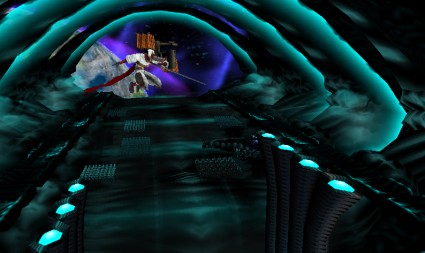
This game is for those who like challenge.
For a certain type of person…
Shinobi on 3DS is one of those odd little games, that despite alienating a large portion of a potential audience with its difficulty and not being quite polished enough in some areas, manages to achieve every goal that was outlined for it. Griptonite were asked to provide an experience that was true to the original game, by being challenging and old-school by design. In that respect, they have done everything that was asked of them.
Whether that makes for a good game or not will depend entirely on your own viewpoint. If you’re the type easily put off by archaic controls, repetition and the premise of playing sections over and over again until you’ve mastered them, then I’ll advise you to give this a miss. However, for those of the right mindset, those particular aspects are all just part of the fun.
Platforms: 3DS | Tagged 3ds, Katana, Kunai, Ninja, Sega, Shinobi, sword, Throwing knives


